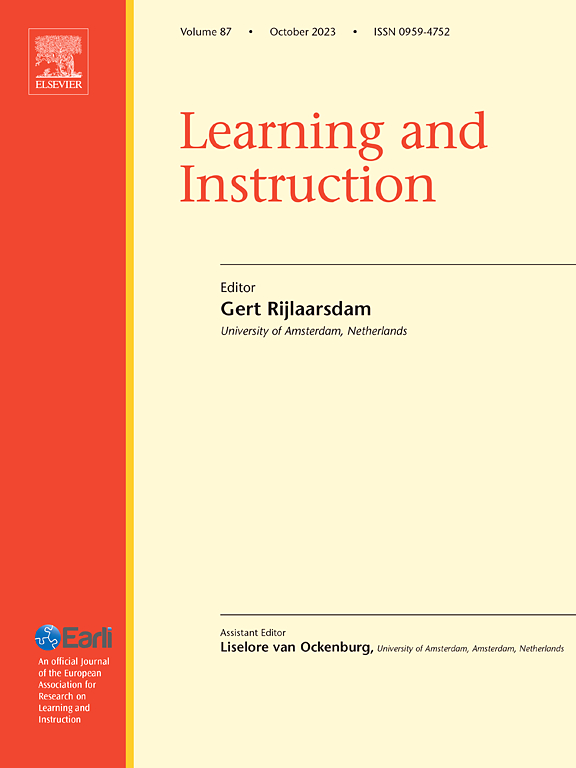A meta-analysis of students’ academic learning losses over the course of the COVID-19 pandemic
IF 4.9
1区 教育学
Q1 EDUCATION & EDUCATIONAL RESEARCH
引用次数: 0
Abstract
Background
In spring 2020, the COVID-19 pandemic led to a disruption of students’ education around the world. School closures led to a shift from in-person learning at school to remote learning, with changes in education persisting over the following years.
Aims
We conducted a meta-analysis to determine if the COVID-19 pandemic was associated with learning losses for school students and to identify potential moderators. We examined learning losses during the pandemic (April 2020–June 2022) and focused on learning losses at different timepoints.
Sample(s)
763 effect sizes from 103 studies conducted in 45 different countries were included in our meta-analysis.
Methods
After an extensive, AI-supported literature search, relevant information from the primary studies was coded. Effect sizes were transformed into Cohen's d. An average effect size was estimated and moderator analyses were conducted for school level, learning domain, country's Human Development Index level, publication type, and study quality. Additionally, overall changes in learning losses were examined in more detail, including a moderator analysis for timepoint of data collection during the pandemic.
Results
Our results showed average learning losses of Cohen's d = −0.20, SE = 0.04, p < .001. Learning domain was the only statistically significant moderator with learning losses being largest in mathematics. The most pronounced learning losses occurred shortly after the onset of the pandemic, but significant learning losses were observed at the majority of the included timepoints.
Conclusions
Learning losses were observed more than two years into the pandemic, highlighting the need to ensure long-term recovery.

对2019冠状病毒病大流行期间学生学业损失的荟萃分析
2020年春季,COVID-19大流行导致世界各地学生的教育中断。学校的关闭导致了从学校面对面学习到远程学习的转变,教育的变化在接下来的几年里一直持续着。目的:我们进行了一项荟萃分析,以确定COVID-19大流行是否与学生的学习损失有关,并确定潜在的调节因素。我们研究了大流行期间(2020年4月至2022年6月)的学习损失,并重点研究了不同时间点的学习损失。我们的荟萃分析包括来自45个不同国家的103项研究的763个效应大小样本。方法在人工智能支持下进行广泛的文献检索后,对原始研究的相关信息进行编码。效应量转化为Cohen’s d。估计平均效应量,并对学校水平、学习领域、国家人类发展指数水平、出版物类型和研究质量进行调节分析。此外,更详细地审查了学习损失的总体变化,包括对大流行期间数据收集时间点的调节分析。结果Cohen’s的平均学习损失d = - 0.20, SE = 0.04, p <;措施。学习领域是唯一具有统计学意义的调节因子,学习损失在数学方面最大。最明显的学习损失发生在大流行开始后不久,但在大多数纳入的时间点都观察到严重的学习损失。大流行发生两年多后,出现了学习损失,这凸显了确保长期恢复的必要性。
本文章由计算机程序翻译,如有差异,请以英文原文为准。
求助全文
约1分钟内获得全文
求助全文
来源期刊

Learning and Instruction
Multiple-
CiteScore
11.30
自引率
4.80%
发文量
109
期刊介绍:
As an international, multi-disciplinary, peer-refereed journal, Learning and Instruction provides a platform for the publication of the most advanced scientific research in the areas of learning, development, instruction and teaching. The journal welcomes original empirical investigations. The papers may represent a variety of theoretical perspectives and different methodological approaches. They may refer to any age level, from infants to adults and to a diversity of learning and instructional settings, from laboratory experiments to field studies. The major criteria in the review and the selection process concern the significance of the contribution to the area of learning and instruction, and the rigor of the study.
 求助内容:
求助内容: 应助结果提醒方式:
应助结果提醒方式:


